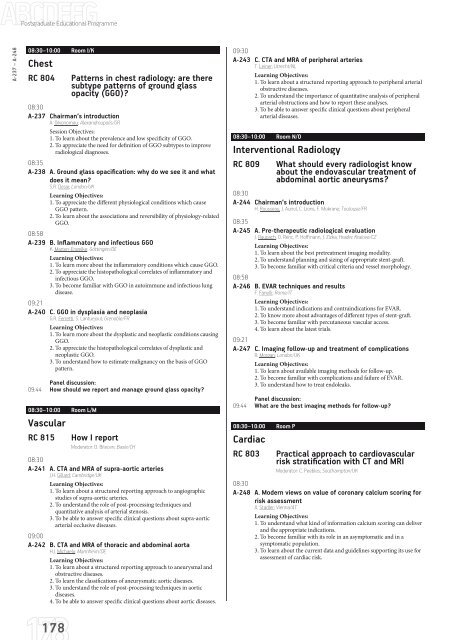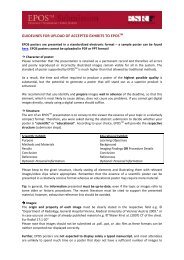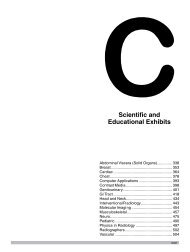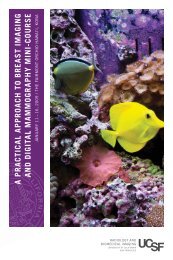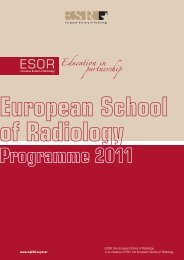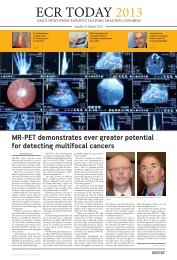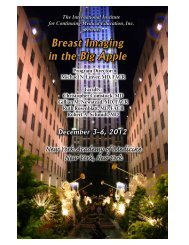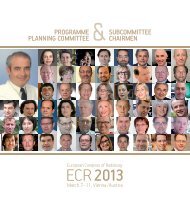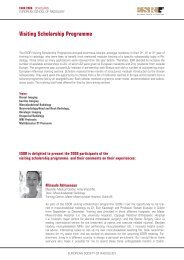ECR 2013 â Final Programme - myESR.org
ECR 2013 â Final Programme - myESR.org
ECR 2013 â Final Programme - myESR.org
- No tags were found...
You also want an ePaper? Increase the reach of your titles
YUMPU automatically turns print PDFs into web optimized ePapers that Google loves.
Postgraduate Educational <strong>Programme</strong>A-237 – A-24808:30–10:00 Room I/KChestRC 804Patterns in chest radiology: are theresubtype patterns of ground glassopacity (GGO)?08:30A-237 Chairman‘s introductionA. Oikonomou; Alexandroupolis/GRSession Objectives:1. To learn about the prevalence and low specificity of GGO.2. To appreciate the need for definition of GGO subtypes to improveradiological diagnoses.08:35A-238 A. Ground glass opacification: why do we see it and whatdoes it mean?S.R. Desai; London/UKLearning Objectives:1. To appreciate the different physiological conditions which causeGGO pattern.2. To learn about the associations and reversibility of physiology-relatedGGO.08:58A-239 B. Inflammatory and infectious GGOK. Marten-Engelke; Göttingen/DELearning Objectives:1. To learn more about the inflammatory conditions which cause GGO.2. To appreciate the histopathological correlates of inflammatory andinfectious GGO.3. To become familiar with GGO in autoimmune and infectious lungdisease.09:21A-240 C. GGO in dysplasia and neoplasiaG.R. Ferretti, S. Lantuejoul; Grenoble/FRLearning Objectives:1. To learn more about the dysplastic and neoplastic conditions causingGGO.2. To appreciate the histopathological correlates of dysplastic andneoplastic GGO.3. To understand how to estimate malignancy on the basis of GGOpattern.Panel discussion:09:44 How should we report and manage ground glass opacity?08:30–10:00 Room L/MVascularRC 815How I reportModerator: D. Bilecen; Basle/CH08:30A-241 A. CTA and MRA of supra-aortic arteriesJ.H. Gillard; Cambridge/UKLearning Objectives:1. To learn about a structured reporting approach to angiographicstudies of supra-aortic arteries.2. To understand the role of post-processing techniques andquantitative analysis of arterial stenosis.3. To be able to answer specific clinical questions about supra-aorticarterial occlusive diseases.09:00A-242 B. CTA and MRA of thoracic and abdominal aortaH.J. Michaely; Mannheim/DELearning Objectives:1. To learn about a structured reporting approach to aneurysmal andobstructive diseases.2. To learn the classifications of aneurysmatic aortic diseases.3. To understand the role of post-processing techniques in aorticdiseases.4. To be able to answer specific clinical questions about aortic diseases.09:30A-243 C. CTA and MRA of peripheral arteriesT. Leiner; Utrecht/NLLearning Objectives:1. To learn about a structured reporting approach to peripheral arterialobstructive diseases.2. To understand the importance of quantitative analysis of peripheralarterial obstructions and how to report these analyses.3. To be able to answer specific clinical questions about peripheralarterial diseases.08:30–10:00 Room N/OInterventional RadiologyRC 809 What should every radiologist knowabout the endovascular treatment ofabdominal aortic aneurysms?08:30A-244 Chairman‘s introductionH. Rousseau, J. Auriol, C. Lions, F. Mokrane; Toulouse/FR08:35A-245 A. Pre-therapeutic radiological evaluationJ. Raupach, O. Renc, P. Hoffmann, J. Zizka; Hradec Kralove/CZLearning Objectives:1. To learn about the best pretreatment imaging modality.2. To understand planning and sizing of appropriate stent-graft.3. To become familiar with critical criteria and vessel morphology.08:58A-246 B. EVAR techniques and resultsF. Fanelli; Rome/ITLearning Objectives:1. To understand indications and contraindications for EVAR.2. To know more about advantages of different types of stent-graft.3. To become familiar with percutaneous vascular access.4. To learn about the latest trials.09:21A-247 C. Imaging follow-up and treatment of complicationsR. M<strong>org</strong>an; London/UKLearning Objectives:1. To learn about available imaging methods for follow-up.2. To become familiar with complications and failure of EVAR.3. To understand how to treat endoleaks.Panel discussion:09:44 What are the best imaging methods for follow-up?08:30–10:00 Room PCardiacRC 803Practical approach to cardiovascularrisk stratification with CT and MRIModerator: C. Peebles; Southampton/UK08:30A-248 A. Modern views on value of coronary calcium scoring forrisk assessmentA. Stadler; Vienna/ATLearning Objectives:1. To understand what kind of information calcium scoring can deliverand the appropriate indications.2. To become familiar with its role in an asymptomatic and in asymptomatic population.3. To learn about the current data and guidelines supporting its use forassessment of cardiac risk.178


